Keywords of Chinese OEMs going to Germany: electric vehicles, cost performance, intelligence, ecological construction, localization
The European Union's temporary tariffs on electric vehicles in China came into effect on July 5, 2024, and will last for up to four months. SAIC Motor Group's additional tax rate is 37.6%, Geely's is 19.9%, and BYD's is 17.4%. Other OEMs that cooperate with European Union investigation have an average additional tax rate of 20.8%, and those that do not cooperate with the investigation have an additional tax rate of 37.6%. Compared with the data disclosed by the European Union on June 12, the tax rate determined this time has been slightly reduced.
A number of German OEMs and institutions have joined forces to express their clear opposition to European Union's policy of imposing tariffs on electric vehicles in China. They believe that this will not only seriously harm the interests of European consumers and European companies, but also delay the low-carbon development of European transportation industry.
In this context, ResearchInChina recently released "Chinese OEMs (Passenger Car) Going Overseas Report, 2024--Germany", which provides a detailed analysis of strategic layout and planning adopted by automakers when entering German automotive market, with the aim of providing valuable reference and inspiration for the industry.
1. Sales of Chinese cars in Germany account for only 3.0%, and 96% are new energy vehicles?
In 2023, German passenger car market sales totaled 2.845 million units, an increase of 7.3% year-on-year. In terms of the proportion of car sales of different car series, German cars hold a stable share of more than half of German market. This is followed by French multinational groups Stellantis and Renault-Nissan Alliance, as well as Korean, American and Japanese brands. In contrast, Chinese cars performed slightly worse in German market, with sales accounting for only 3.0%.
In addition, Germany's new energy vehicle sales were 1.358 million, accounting for 47.7% of total sales, an increase of 5.5% year-on-year. Among them, Chinese automakers sold 2.8% of new energy vehicles in Germany.

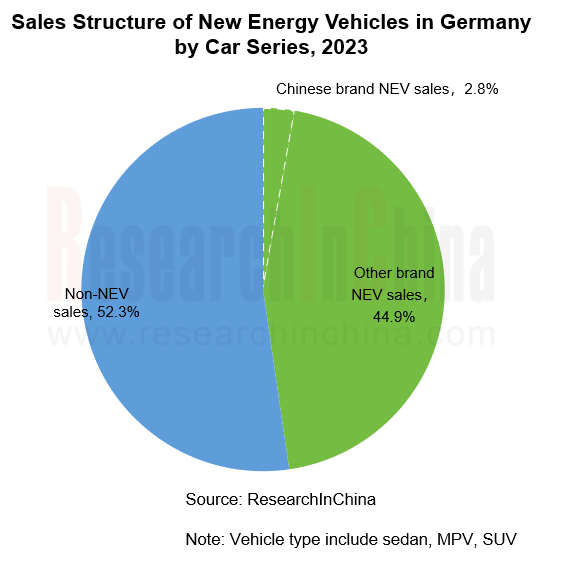
2. Export of Chinese brands to Germany focuses on cost performance and advanced configuration
According to the German car consumer survey by T-online in 2023, 30% of German consumers who are willing to buy a mid-range car are due to the lower price of mid-range car, and another 15% are due to advanced configuration.
According to configuration provided by mobile.de, Germany's largest car market, new energy vehicles such as BYD ATTO 3 and SAIC MG4 at the same price can provide more vehicle functions/services than Volkswagen Golf.
In terms of vehicle navigation functions that German consumers are most concerned about, the best-selling models of BYD and SAIC MG both use Here Map intelligent navigation system. The system not only has basic navigation functions, but also automatically displays charging stations that can be replenished along the way when planning the driving route. The system supports automatic planning of reasonable driving and charging routes, effectively solving the problem of charging anxiety for users during long-distance driving.
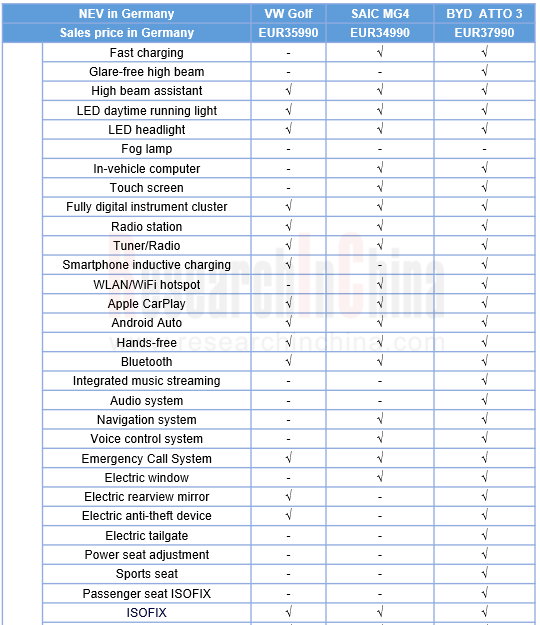
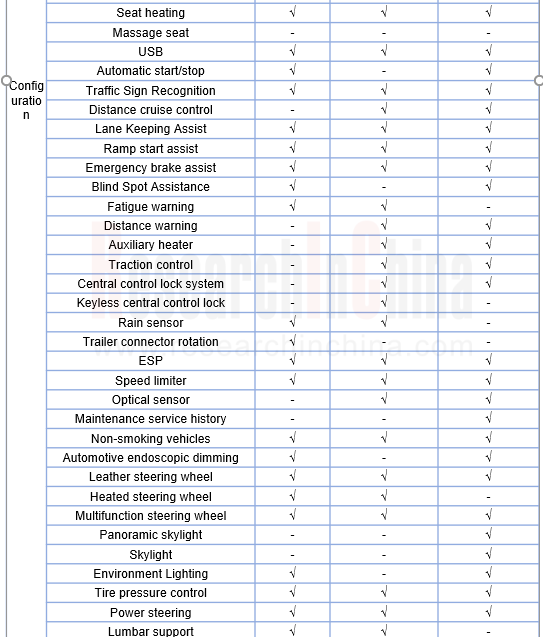
In addition to offering more abundant configurations at the same price to attract German consumers, Chinese automakers are also actively planning and deploying a network of electric charging facilities in Germany to ease the charging anxiety of local electric vehicle users. In response to the common pain points of underground garages in the German market, such as poor signal, high failure rate of charging piles, poor compatibility of charging apps, and different charging facilities standards, Chinese automakers such as NIO have partnered with German energy supplier EnBW, charging infrastructure company Mer, and RWE to accelerate the construction of substation stations in Germany, striving to fundamentally improve the charging experience. In addition, BYD and Shell have also reached a strategic cooperation agreement. The two companies will set up BYD-Shell EV charging centers in major European markets, integrate the resources of both parties, optimize the charging process and digital services, and enhance the user experience.
3. European Union's response strategy after adding tariffs, localized factory building is the optimal but not the only solution
The three major export strategies of Chinese automakers to expand overseas markets are vehicle exports, parts exports and technical cooperation exports. For German market, Chinese automakers mainly adopt two key paths of vehicle exports and technical cooperation exports to deepen market penetration.
Chinese automakers enter German market by exporting complete vehicles:
In the early stage of overseas market expansion, the export of complete vehicles is the preferred strategy of most OEMs. With increase in sales of models in German market and implementation of European Union tariff policy, some Chinese OEMs such as BYD (announced at the end of 2023 that it will build the first new energy vehicle factory in Hungary) and SAIC (also plans to build a factory in Europe) have adopted the local factory approach to avoid tariff barriers, cut production costs and further enhance market competitiveness of products.
?????
Chinese automakers enter German market through technical cooperation:
In addition to the factory construction model that focuses on asset investment, Leopmotor, an emerging automaker whose sales in German market are still in their infancy, has adopted? overseas strategy of technical cooperation. In 2023, Leopmotor and Stellantis Group jointly established a joint venture "Leopmotor International". Based on Stellantis' global network resources and channel advantages, Leopmotor can achieve rapid penetration of overseas markets and enhance its global market competitiveness. Under this cooperation framework, Leopmotor will focus on core technology R&D, design and manufacturing, while Stellantis will provide marketing, sales network, after-sales services and other support. Finally, Leopmotor will be launched to nine European countries including Germany based on Leopmotor International.
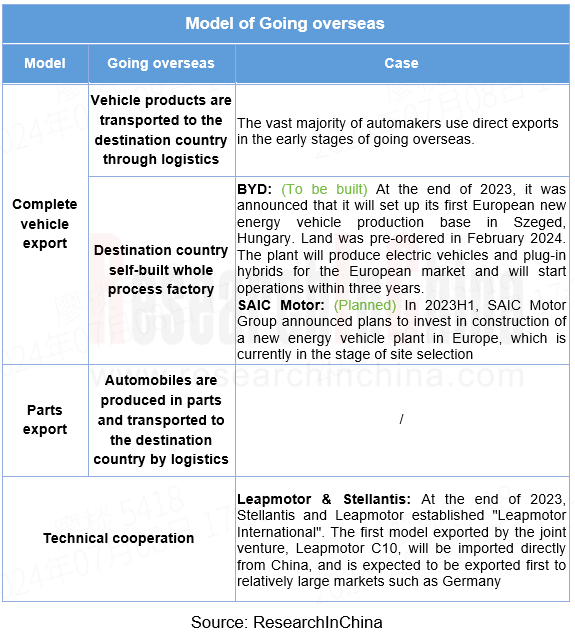
Chinese automakers set up different technology centers to deepen German market:
In order to integrate more deeply into overseas markets and achieve more stable and long-term development in? German automotive market, Chinese automakers have also established R&D centers, design centers, and intelligent driving centers in Germany.
In April 2024, NIO officially established? Smart Driving Technology Center in the Sch?nefeld area next to its Berlin Innovation Center, which opened in 2023. This strategic layout aims to create an excellent smart driving experience for users in European market through deep integration and efficient collaboration of the two centers, closely combining the unique driving environment in Europe, the individual needs of users, and the strict regulatory framework.
In June 2024, SAIC announced that it would establish an engineering and technology center in Frankfurt, Germany, and send SAIC engineers to directly connect with European automotive industry chain, dealers, and users to create an efficient local R & D system.
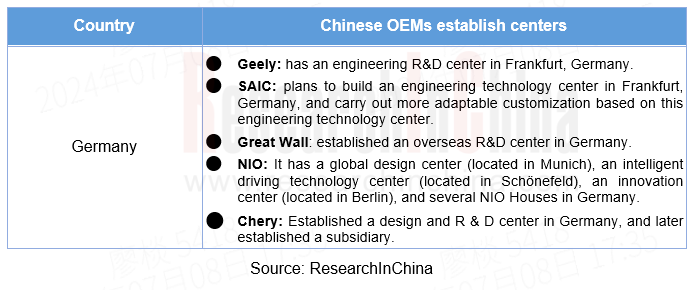
Different Chinese car brands flexibly adjust their expansion strategies in German market:
In addition, the market expansion strategies of Chinese OEMs in German market also have their own characteristics. NIO adheres to the direct sales method, and builds a complete operation system of "product + service" independently by copying the successful experience in China. It does not cooperate with local dealers. In contrast, Xpeng initially tried direct sales in Denmark, adjusted its strategy, and switched to a dealer model in most European markets. In particular, it cooperated with 12 dealers in Germany, and plans to significantly expand its distribution network and retail terminals in the next few years. BYD and Great Wall have chosen to cooperate with dealers, working with different partners to explore German market.
Geely's Smart and SAIC MG have adopted a unique direct agent model in Germany, which combines the advantages of dealers and direct sales. This model can not only directly face consumers, but also use the dealer network to achieve multi-channel sales and service coverage. These different sales models reflect the flexibility of each brand to adjust according to its own strategy and market environment.
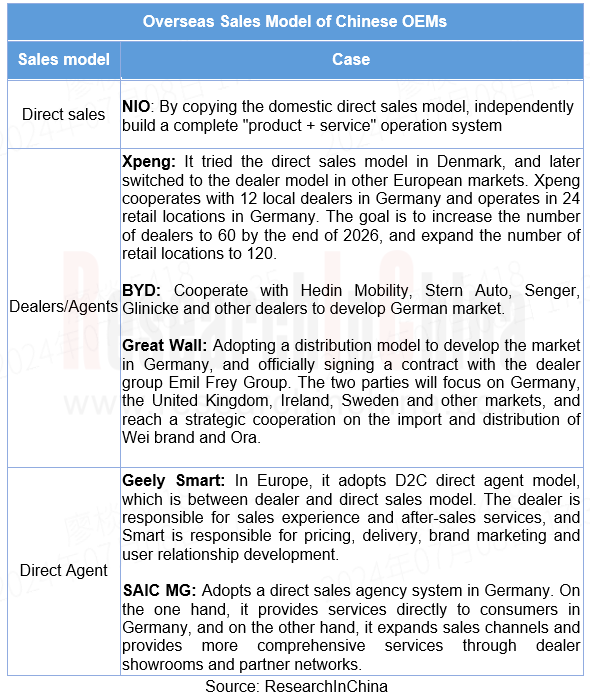
In the future, ResearchInChina will continue to expand the scope of research based on the key markets of Chinese automakers going overseas, and successively launch a series of reports such as Thailand and Brazil, providing a more comprehensive and in-depth reference for the industry's overseas strategy.
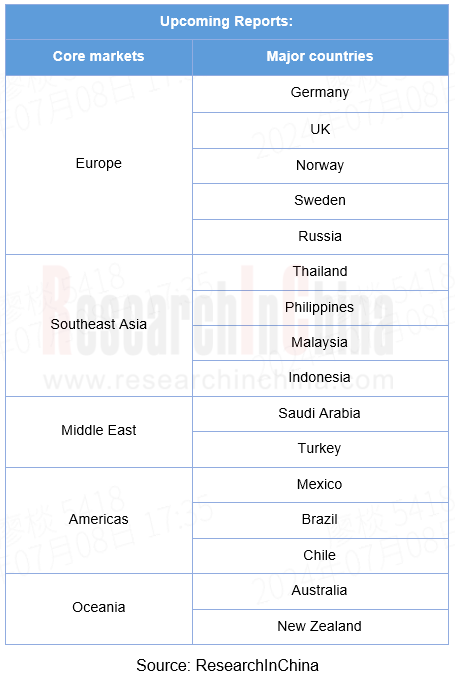
Autonomous Driving Domain Controller and Central Computing Unit (CCU) Industry Report, 2025
Research on Autonomous Driving Domain Controllers: Monthly Penetration Rate Exceeded 30% for the First Time, and 700T+ Ultrahigh-compute Domain Controller Products Are Rapidly Installed in Vehicles
L...
China Automotive Lighting and Ambient Lighting System Research Report, 2025
Automotive Lighting System Research: In 2025H1, Autonomous Driving System (ADS) Marker Lamps Saw an 11-Fold Year-on-Year Growth and the Installation Rate of Automotive LED Lighting Approached 90...
Ecological Domain and Automotive Hardware Expansion Research Report, 2025
ResearchInChina has released the Ecological Domain and Automotive Hardware Expansion Research Report, 2025, which delves into the application of various automotive extended hardware, supplier ecologic...
Automotive Seating Innovation Technology Trend Research Report, 2025
Automotive Seating Research: With Popularization of Comfort Functions, How to Properly "Stack Functions" for Seating?
This report studies the status quo of seating technologies and functions in aspe...
Research Report on Chinese Suppliers’ Overseas Layout of Intelligent Driving, 2025
Research on Overseas Layout of Intelligent Driving: There Are Multiple Challenges in Overseas Layout, and Light-Asset Cooperation with Foreign Suppliers Emerges as the Optimal Solution at Present
20...
High-Voltage Power Supply in New Energy Vehicle (BMS, BDU, Relay, Integrated Battery Box) Research Report, 2025
The high-voltage power supply system is a core component of new energy vehicles. The battery pack serves as the central energy source, with the capacity of power battery affecting the vehicle's range,...
Automotive Radio Frequency System-on-Chip (RF SoC) and Module Research Report, 2025
Automotive RF SoC Research: The Pace of Introducing "Nerve Endings" such as UWB, NTN Satellite Communication, NearLink, and WIFI into Intelligent Vehicles Quickens
RF SoC (Radio Frequency Syst...
Automotive Power Management ICs and Signal Chain Chips Industry Research Report, 2025
Analog chips are used to process continuous analog signals from the natural world, such as light, sound, electricity/magnetism, position/speed/acceleration, and temperature. They are mainly composed o...
Global and China Electronic Rearview Mirror Industry Report, 2025
Based on the installation location, electronic rearview mirrors can be divided into electronic interior rearview mirrors (i.e., streaming media rearview mirrors) and electronic exterior rearview mirro...
Intelligent Cockpit Tier 1 Supplier Research Report, 2025 (Chinese Companies)
Intelligent Cockpit Tier1 Suppliers Research: Emerging AI Cockpit Products Fuel Layout of Full-Scenario Cockpit Ecosystem
This report mainly analyzes the current layout, innovative products, and deve...
Next-generation Central and Zonal Communication Network Topology and Chip Industry Research Report, 2025
The automotive E/E architecture is evolving towards a "central computing + zonal control" architecture, where the central computing platform is responsible for high-computing-power tasks, and zonal co...
Vehicle-road-cloud Integration and C-V2X Industry Research Report, 2025
Vehicle-side C-V2X Application Scenarios: Transition from R16 to R17, Providing a Communication Base for High-level Autonomous Driving, with the C-V2X On-board Explosion Period Approaching
In 2024, t...
Intelligent Cockpit Patent Analysis Report, 2025
Patent Trend: Three Major Directions of Intelligent Cockpits in 2025
This report explores the development trends of cutting-edge intelligent cockpits from the perspective of patents. The research sco...
Smart Car Information Security (Cybersecurity and Data Security) Research Report, 2025
Research on Automotive Information Security: AI Fusion Intelligent Protection and Ecological Collaboration Ensure Cybersecurity and Data Security
At present, what are the security risks faced by inte...
New Energy Vehicle 800-1000V High-Voltage Architecture and Supply Chain Research Report, 2025
Research on 800-1000V Architecture: to be installed in over 7 million vehicles in 2030, marking the arrival of the era of full-domain high voltage and megawatt supercharging.
In 2025, the 800-1000V h...
Foreign Tier 1 ADAS Suppliers Industry Research Report 2025
Research on Overseas Tier 1 ADAS Suppliers: Three Paths for Foreign Enterprises to Transfer to NOA
Foreign Tier 1 ADAS suppliers are obviously lagging behind in the field of NOA.
In 2024, Aptiv (2.6...
VLA Large Model Applications in Automotive and Robotics Research Report, 2025
ResearchInChina releases "VLA Large Model Applications in Automotive and Robotics Research Report, 2025": The report summarizes and analyzes the technical origin, development stages, application cases...
OEMs’ Next-generation In-vehicle Infotainment (IVI) System Trends Report, 2025
ResearchInChina releases the "OEMs’ Next-generation In-vehicle Infotainment (IVI) System Trends Report, 2025", which sorts out iterative development context of mainstream automakers in terms of infota...